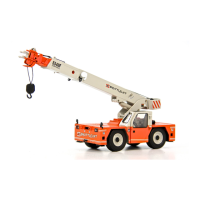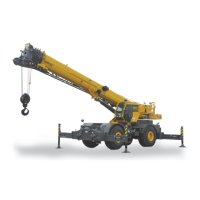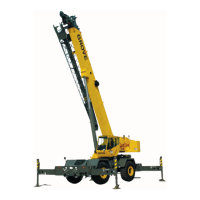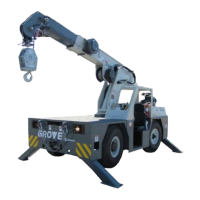GROVE Published 10-21-2010, Control# 198-04 4-23
5540F/YB5515 SERVICE MANUAL HYDRAULIC SYSTEM
CROWD CIRCUIT
General
The crowd circuit includes the crowd cylinder, a holding
valve, ports 5 and 6 of the hydraulic swivel, an anti-double
block cutout solenoid valve, a section of the main control
valve, and the hydraulic lines.
Oil Flow
Crowd Out
Pushing the handle spool OUT connects the supply from the
pump to cylinder port A of the control valve section
Figure 4-25. Oil leaves Port A and is routed through the
hydraulic swivel port 6 to the base end of the cylinder.
In the extending direction, oil flows freely through the holding
valve and into the base end of the cylinders. The cylinders
extend and push oil ahead of the piston through the rod end
port of the cylinders. The oil returns through swivel port 5 and
Port A of the control valve. From here, the oil is routed into
the tank passage and returns through the return filter to the
hydraulic tank.
The anti-double block valve will shut off the oil supply to the
crowd cylinder in the event the hook block comes in contact
with the boom head. In this case the operator must let out
more wire on the main winch before he can extend the boom.
Crowd In
Pulling the handle spool IN routes oil out of valve port B and
through the port 5 of the hydraulic swivel to the rod port of the
hydraulic cylinders Figure 4-26. The cylinder starts to retract
but meets resistance from the oil held in the cylinder base
end by the holding valve. This restriction causes an increase
in pressure as the pump continues to push more oil into the
rod port of the cylinders. When the pressure is high enough
to open the holding valve, the cylinder retracts. See Holding
Valve.
Oil from the rod end of the cylinders return through port 6 of
the hydraulic swivel to the control valve. From here, the oil is
routed through the return filter to the hydraulic tank.
Holding Valve
The holding valve has three functions:
1. Inhibit cavitation of the cylinder.
2. Give full control of the lowering of the boom.
3. Hold the load in event of a hydraulic failure.
Pilot pressure from the rod side of the piston opens the
holding valve. If the cylinder starts to retract faster than the
pump can fill the cylinder, there will be a decrease in the pilot
pressure. The holding valve will close and interrupt the flow
of oil from the cylinder. The holding valve will interrupt the
flow as often as necessary to keep the cylinder filled. Also, if
there is a failure of the pump or a hydraulic line, the holding
valve will hold the boom in position.
Engine speed is important for smooth operation. At low
engine speed, normally there will not be enough oil from the
pump to keep the cylinder filled. As a result, the boom will
move down in a movement that is not regular.
WARNING
Do not adjust the holding valve setting. The valve is
adjusted by the manufacturer.
Reference Only
